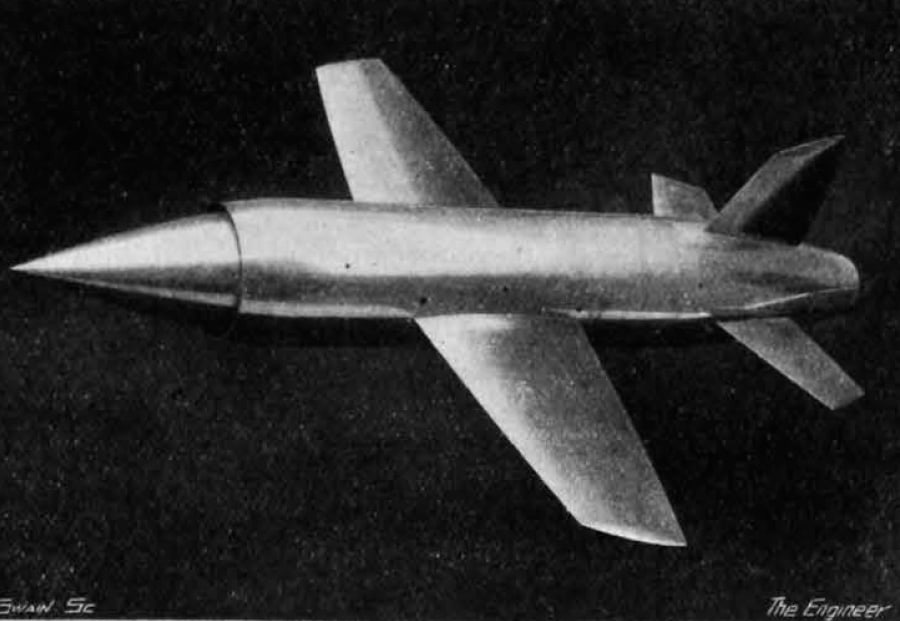The story of the Miles M52 aircraft is an intriguing tale of what might have been. In September 1946, The Engineer published a feature based on details that had recently been released by the Ministry of Defence. Just a few months earlier, the British government had cancelled the programme due to budget constraints, despite the design of the supersonic research aircraft being almost complete, and the construction of the first of three prototypes well underway.

Miles Aircraft of Reading had been tasked with building the turbojet-powered M52, which was intended to fly at 1,000 mph and reach a height of 36,000ft within 90 seconds. To achieve this, the engineers at Miles came up with a radical design more reminiscent of a piece of weaponry.
“Resembling a winged bullet, the overall dimensions were to have been 33ft long and 27ft wing span, the wings being somewhat shorter than those of aircraft of similar length,” The Engineer wrote 70 years ago.
“As a step towards producing a wing shape which has a low drag in the supersonic speed range and yet permits low speed flight with good control, Miles Aircraft Ltd designed a bi-convex wing, with very sharp leading and trailing edges.”
This bi-convex wing was tested on a standard Miles Falcon and then later in combination with a moving tailplane, proving the design’s stability at low speeds. The power plant, which would have produced 17,000 horsepower at full-speed flight, was to be supplied by Power Jets (Research and Development) Ltd. Alongside the fuel tank and flight controls, the engine would have taken up almost the entire fuselage.
“It can be described as a three-stage unit, the first stage consisting of an ordinary jet engine with centrifugal blower,” our predecessors wrote. “Gases from this engine pass through a turbine, which also serves as a ducted fan, bringing in an additional supply of air, which is mixed into the main stream.
“The mixture then passes through an ‘athodyd’ (aero-thermo-dynamic duct), into which fuel is injected and burnt, thereby increasing still further the speed of the gases, which are finally ejected by a nozzle in the tail. The power plant is 3.5ft in diameter and 23ft long.”
With all that power just inches from the pilot, as well as the extreme heights the M52 would be operating at, it’s no surprise that an ejection system was in place. The pressurised cockpit was designed to be completely jettisoned by detonating charges of plastic explosive in the tubular structures that connected the cabin to the fuselage. In theory, the air pressure would force the cockpit clear of the aircraft, and a parachute would help it descend gradually.
Once the cabin had slowed to a reasonable speed and descended to a designated height, the pilot would then bale out using a parachute of his own. If you were lucky enough to make it back to Earth in a fully intact aircraft, landing sounds like it could have been almost as terrifying as a bale-out.
“For the undercarriage special tyres and wheels had to be designed, as the touch-down speed was likely to have been about 170mph, with a two-mile run before stopping. The designed all-up weight is about 8,200lb at take-off, giving a wing loading of 58lb per square foot.”
Although a piloted M52 never took to the skies, an unmanned version roughly 30 per cent the original scale did. It launched from a modified de Havilland Mosquito on 8 October 1947, but its rocket exploded shortly after release. Six days later Chuck Yeager broke the sound barrier for the first time in the Bell X-1, an aircraft that shared many similarities with the British design. In October 1948, an unmanned M52 reached Mach 1.38 in stable level flight.
Dennis Bancroft, chief aerodynamicist at Miles, later claimed Bell Aircraft was given access to the drawings and research on the M52, but that the US reneged on its side of a knowledge-sharing agreement made in 1944, and that no US data came back in return. At this point, the X-1 was supposedly struggling with conventional tail designs, and the variable incidence tail used on the M52 is said to have inspired a similar device on the record-breaking US craft.
Unsurprisingly, claims of British influence on the iconic Bell X-1 are widely disputed in the US, and history is generally written by the victors. But perhaps with a little more funding on this side of the Atlantic, the M52 just might have given Chuck Yeager and the X-1 a run for their money.




Glasgow trial explores AR cues for autonomous road safety
They've ploughed into a few vulnerable road users in the past. Making that less likely will make it spectacularly easy to stop the traffic for...